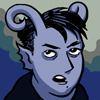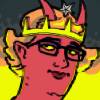 BfS: I’m not sure which story we had been reading before, but I found it in the wikipedia page as being similar, a way I’ve found a lot of great stories. Thanks wiki editors!
BfS: I’m not sure which story we had been reading before, but I found it in the wikipedia page as being similar, a way I’ve found a lot of great stories. Thanks wiki editors!GAS: I actually love looking at literary classics and seeing their flaws, because as a creator it makes me feel more like I could write something that ranks well with the greats. There are flawless stories, like the works of Kafka we’ve read, but even some really strong ones have issues. This story is real cool, but weaker than most of the classics we’ve read, and probably for that exact reason.
GAS: Maybe dismissing art you don’t like as “not actually art” was more popular in the 20th century. OK. What did you find strong about it? To the extent you can say without spoilers. What moved your imagination?
BfS: The premise is very strong, probably why so many people have done interpretations and offshoots. Makes you want to see more done with it. The author is said to have been inspired by a real life ruin he visited, and was trying to get at the feeling it gave him. I think that’s a good thing to aspire toward, the sense of awe and mystery you can get, even if it’s better done in stories like the Willows.
GAS: That’s why I was thinking of eyeshine, that part. I remember now. Good shit. I had a thought that this story has something in common with the song Gloomy Sunday. That song was about suicide, which was and is very taboo. Back when it came out, it was credited with causing many suicides. I have no doubt it was quoted by the suicidal, but causative? No. And it’s pretty tame. The song ends with “I was only dreaming.” Looks quaint to modern eyes, doesn’t live up to its infamy. So with The Great God Pan. I can’t imagine it corrupting the masses with its sexy ways, but the idea was there.
BfS: Yeah in terms of horror, it was very tame compared to what Poe was doing decades earlier, or contemporary French writers. The French were doing much sexier things as well, but I suppose that’s not too surprising.
–
Addendum: One observation about The Notorious GGP that I forgot to mention here, but I noticed as I read. It was clearly a direct inspiration to Peter Straub’s Ghost Story, so much so that I feel his book was intended both as a sequel and as an exploration and expansion of the things in the original which were left unsaid. The movie adaptation of Ghost Story ignored and changed the true nature of the monster from the novel, which was more similar to Pan.
–

 GAS: That is pretty cool of them. What initially intrigued you about it?
GAS: That is pretty cool of them. What initially intrigued you about it?
Machen’s Pan is definitely a classic, but actually not one of my favourites of this author.
My favourite Machen story would be “The White People”. A bit lengthy maybe and more weird than horror but I enjoyed it much more. It just had this atmosphere of something strange, vaguely seen that, despite the narrators condemnation, I’m not sure was really evil.
Others like “The Novel of the Black Seal” or “The Novel of the White Powder” are much less spectacular than Pan, but somehow appeal to me more, maybe because they are simpler stories.
Machen’s big idea that showed up in a lot of stores was the continued hidden existence of previous inhabitants of the British Isles, primitive, degenerate, maybe not quite as human as us. I enjoyed reading about his little people, but damn, there is quite a bit of racism in that concept. Robert E. Howard wrote a few stories based in Machen’s idea and made the racism a bit more obvious.
love a comment on one of these with specific reading recs.
For cosmic horror?
I’m more into SF than horror, but I can point to a few things — you may already know about these, though.
On the less SFish, more traditional site, Stephen King himself has at least flirted with it a fair bit. Most strongly in a short story that’s just named “N”. The famous (or notorious?) Dark Tower heptology, which makes War and Peace look short, definitely has elements of it, but it’s a pretty big commitment.
SF, of course, tends to accept a basically scientific worldview, so is inherently very skeptical of the belief that there was anything we were “not meant to know”. But it can certainly have knowledge we’re not ready for yet, as well as messages that are damaging because they are disinformation. And it has absolutely gone into territory that I’d say can be classed as cosmic horror.
Small-commitment:
* The movie “Event Horizon”. Has supernatural/fantasy elements so is not pure SF
* “Flying to Valhalla”, by Charles Pellegrino. Our first forays beyond the solar system find creepy effects and danger. An early iteration of the “dark forest” concept, arguably.
* “Dust”, same author, has eco-horror more than cosmic horror, but you implied an interest in that too, so I’m including it. It’s somewhat longer than the previous entries.
* “Blindsight”, by Peter Watts. Like “N” and “Flying to Valhalla”, but unlike most of the others, has sanity/mental health horror alongside a fair dose of the dark forest.
* “Forge of God”, by Greg Bear: more early dark forest, but it’s tone is more thriller than horror overall. There’s a sequel that is more adventure than thriller *or* horror. One civilization is trying to bring the rule of law to the dark forest. Both are longer than most of the previous entries aside from, maybe, “Dust”.
Larger commitment:
* “The Three-Body Problem” trilogy, by Liu Cixin. The trope namer for “dark forest” is the second volume of this series. The cosmic horror elements are mainly in the third. Psychological horror aspects are present throughout, though are not as prominent as in “N” or Lovecraft. Characters are driven to hopelessness, in some cases suicide, and in a couple, murder, so be warned. This is a larger commitment because the real serious horror payoffs wait for the third book. (Believe it or not, someone even gets the Mola Ram treatment in the third book. And it’s one of the least of the horrible things to happen.) Turns out maybe there are things man would not want to know.
A key aspect to these as that they repudiate “human triumphalism” or “human exceptionalism”, often vehemently, unlike probably most science fiction. (An even earlier iteration of dark forest concept, Saberhagen’s berserker stories, is loaded with said triumphalism so can’t possibly qualify as cosmic horror.)